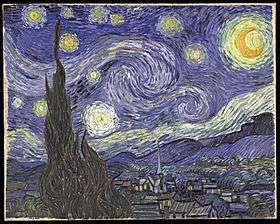Timbres, espace, mouvement
Timbres, espace, mouvement (Timbre, space, movement) is a work for orchestra composed by Henri Dutilleux in 1978. Dutilleux subtitled the work La nuit etoilée (The Starry Night), in reference to the painting by Vincent Van Gogh. The composer wanted to translate in his composition the "almost cosmic whirling effect which (the painting) produces".[1] Dutilleux dedicated the work to the memory of Charles Münch and to Mstislav Rostropovich, the conductor of its premiere.

This instrumentarium consists of:
- 2 piccolos (who double on flute)
- 2 flutes (second flute doubles on alto flute)
- 3 oboes
- oboe d'amore
- E-flat clarinet
- 2 clarinets in A
- bass clarinet
- 3 bassoons
- contrabassoon
- 4 horns
- 3 trumpets
- 3 trombones
- tuba)
- 12 celli
- 10 double basses
- percussion (crotales, suspended cymbals, tam-tams, bongos, tom-toms, snare drum, marimba, glockenspiel)
- harp
- celesta
- timpani
Dutilleux has omitted violins and violas from his instrumentation. Their absence was meant to translate the impression of relative emptiness and immobility conveyed by the lower half of the painting. On the other hand, the wind instruments and percussions are particularly prominent. Their solos represent the movements of the clouds and the light of the stars and the moon. Space is represented by an unusual distribution of the celli. They are placed at the foreground in a half circle around the conductor. The movement is symbolized by the alternation of static episodes and whirling solos.
Mstislav Rostropovich commissioned the work, and conducted the premiere with Washington National Symphony Orchestra on 7 November 1978. Dutilleux revised the work in 1990 with the addition of an interlude for 12 cellos between the two original movements. The work is approximately 20 minutes' duration.
References
- ↑ French,"effet de tournoiement quasi cosmique qui s'en dégage" – Dutilleux.
External links
Sources
- Henri Dutilleux: His Life and Works, Caroline Potter ISBN 1-85928-330-6
- Henri Dutilleux:Timbres, espace, mouvement on max-texier.ircam.fr
- Dutilleux, Henri at The Living Composers Project Contains information on orchestral composition